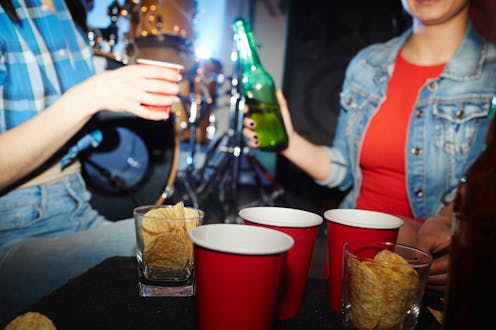Alcohol is becoming more common in sexual assault among college students
An increasing number of college students say they were victims or perpetrators of sexual assault – and that victims were drunk when the assault took place. Are campus drinking environments to blame?

The Research Brief is a short take about interesting academic work.
The big idea
One out of every three. That is the number of women in college who say they have been a victim of sexual assault either when they were in high school or college. That’s according to my new peer-reviewed research in the Journal of Interpersonal Violence, which is based on survey data from 2015.
That figure is significantly higher than it was in the mid-1980s when I conducted the first such national survey of college students at 32 institutions. Back then, the number was one out of every four.
Of these incidents, 75% involved victims who admitted they were incapacitated by alcohol at the time of the assault. In the mid-1980s, that number stood at 50%.
For the study, sexual assault was defined consistently with the federal definition of rape. That definition goes beyond forcible rape. It includes oral, anal or vaginal penetration when the victim is too intoxicated to consent.
Among college men, one in 19 admitted during the first survey to having committed sexual assault while in high school or college. That number has increased to one one of every eight.
One thing that hasn’t changed is that the vast majority of college men who responded to the survey say they perpetrated the sexual assault while their victims were incapacitated by alcohol. Then and now, that figure has stood at approximately nine out every 10 college men who admitted to sexual assault. That means the most common scenario for sexual assault of women in college involves men who take advantage of women when they are incapacitated.
For the first survey, conducted in 1985, 6,159 students responded to the questions. For the second survey, which I conducted in 2015 and have been analyzing over the past several years, 2,471 students responded. Both surveys got response rates of more than 90%.
Why it matters
These findings matter because colleges have been trying to implement programs and strategies to reduce irresponsible drinking and the role it plays in sexual assault. If the prevalence of rape is going up instead of down, it calls the effectiveness of these programs into question.
Prior research – including by the Centers for Disease Control and Prevention in Atlanta – has already established that these approaches to alcohol abuse prevention and associated sexual harm have been largely ineffective. That is to say, they neither reduce problematic drinking nor dissuade perpetrators from taking advantage of victims when they are incapacitated.
What’s next
Researchers have suggested a need to take a closer look at trying a more comprehensive approach to preventing sexual violence. This includes modifying drinking environments.
Changing the drinking environment could entail efforts to change or regulate practices at the bars and liquor stores on or near college campuses, such as “2-for-1” drink specials, beer in pitchers, “ladies nights” in which women pay less than men for alcohol or cover charges, and sponsored drinking games, such as beer pong or flip cup.
Mary P. Koss received funding from the U.S. Department of Justice to support this research.
Read These Next
From truce in the trenches to cocktails at the consulate: How Christmas diplomacy seeks to exploit s
World leaders like to talk up peace at Christmastime. But alongside the tales of seasonal breaks in…
As DOJ begins to release Epstein files, his many victims deserve more attention than the powerful me
Powerful men connected to Jeffrey Epstein are named, dissected and speculated about. The survivors,…
The world risks forgetting one of humanity’s greatest triumphs as polio nears global eradication − 7
Polio may finally be defeated in the next 5 years. Will the world recognize what an extraordinary achievement…





